Weekly birding round-up: 22 - 28 Feb 2017
Well, here we are again. Hello folks.
I’ve no idea when a brief hiatus merges in to a longer leave of absence but after, eeeek, the best part of nine months away from the world of the RBA round-up, I’m back in the saddle of this particular old nag, ready for a late winter trot out of the stable, a roll around in the hay, preparing to disentangle oneself from the confines of that smelly old winter blanket.
Whilst not incurring a Seabiscuit-type injury, it was kind of good to be away from the rarity enclosure for a while, nibble the odd carrot and sugar lump here and there, but only time will tell whether this particular comeback makes its mark as that particular famous and ancient gee-gee did (there’s little likelihood of me being ridden, Hollywood style, by Toby Maguire in a dewey-eyed Oscar nomination film-fest). The mind boggles, but at least I got the correct film, right?
Sacking off the racing analogies (maybe I should have gone down the Floyd Mayweather route for further sporting comparisons - don’t forget, twitching at the sharp end of the listing game is as sporty and as punchy as birding gets) its time to move on and get down to business.
Eventually.
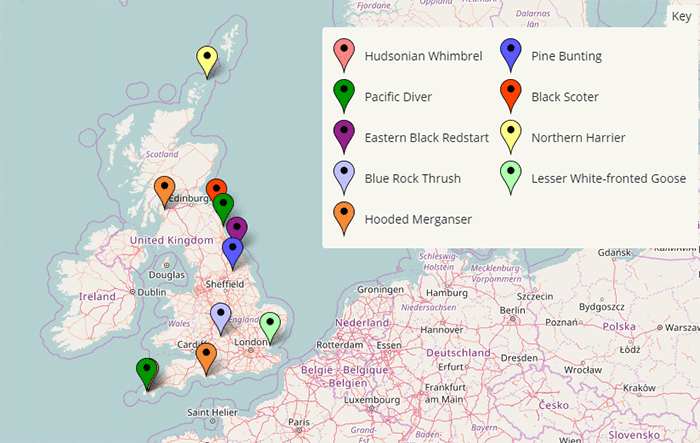
Much has changed, in so many ways, since the last bout of tangential waffle was pushed out from a cottage in north Norfolk sometime last May. In almost every sense…
Our sensibilities were tilted on the collective national axis last summer as the Brexit vote flummoxed some, angered many and brought joy to more. The environmental implications of departing the European Union will be, for many of us, on of the key issues to keep your eyes on, not the rise or fall of human migration and un-relatable economic to-ing and fro-ing. Pin your local UKIP or "Leave" Tory bod down on that particular issue and see what he or she comes up with. When the answer is "ummmm", "eeeerrrrr" or politico gobbledegook, think hard as to why you may have voted as you did…
November too brought a global seismic lurch to the right, as the Cult of Personality triumphed as an increasingly conservative America, plonked a celebrity businessman, with the unnerving look of a flying female Hooded Merganser, in to the White House.
Neo-liberal politics superseded by non-liberal, potentially poisonous, populism. Trump as POTUS - only The Simpsons foresaw that one.
Indeed so much has changed in the past nine months (and nine days) it could take an age to go through everything that, as Peter Griffin once discussed, "really grinds my gears…" so perhaps the soap box ought to be placed back in the corner of the room (it needed a dusting off and an airing, so now’s was good a time as any) and finally (yes, finally) get down to the matter in hand.
There are, after all, scare and rare birds abound and so let’s get under starters orders and see where we end up.
Heading north as I write, it is interesting to head back to the template for this week from this time last year - as much as the world at large has changed, so too has the birding world that we revolve within.
What’s most significant of all? That we have a new list to play with come January 1st 2018, the BOU embracing a New World Order (ok, an IOC World Order); changing taxonomy and six monthly reviews will keep folk on their toes for sure. Insurance policies on big "race-rares", such as Two-barred Greenish Warbler can finally be cashed in; ditto for those who stuck there necks out for a Stejneger’s Stonechat or Eastern Yellow Wagtail - BTW, was that striking, monochrome buzzy beauty on St. Mary’s in 2010 ever submitted? I want to cash some of my own policies here and there too y’know…
Within an instant Hudsonian Whimbrel was demoted to little letters as the IOC announcement was digested, chewed up and spat out and we start to bid a protracted farewell too to Lesser Redpoll (at least give us Hornemann’s by way of recompense eh?). And Eurasian White-fronts suddenly became far sexier when they changed to Russians.
Away from the dark arts of who says what’s what, the most sensational of action of all saw, from a standing start, Siberian Accentor become "commoner" than, for instance Asian Desert Warbler (14:12), Red-necked Stint (14:11) and Audouin’s Gull (14:7) and all within the space of less than five months in rare-birding Britain’s most extraordinary invasion ever. On the south coast, in Sussex, a Red-footed Booby fell under behind-closed-doors media scrutiny (and not much else, "here you go Norman, have a fish and mug like a goon at the cameraman") inducing much "wah"-ing from grown men and women who promptly had a mini-collective sulk in the corner when they didn’t get their way and Dusky Thrush, within an instant, became an "old hat" rare. And that’s just the start of it.
We also now know all about the ageing of a wintering Blue Rock Thrush - or at least way more than we every did before - and this particular cobalt-hued beauty is where we (at long last) kick things off.
In a week that was as mild as mild can be, the sub-singing male Blue Rock Thrush, he of much debate through the initial part of his Stow-in-the-Wold sojourn, the Gloucestershire garden life clearly suiting his needs, still in situ through until 27th, singing from time to time whilst completing a third month on site in to the bargain.
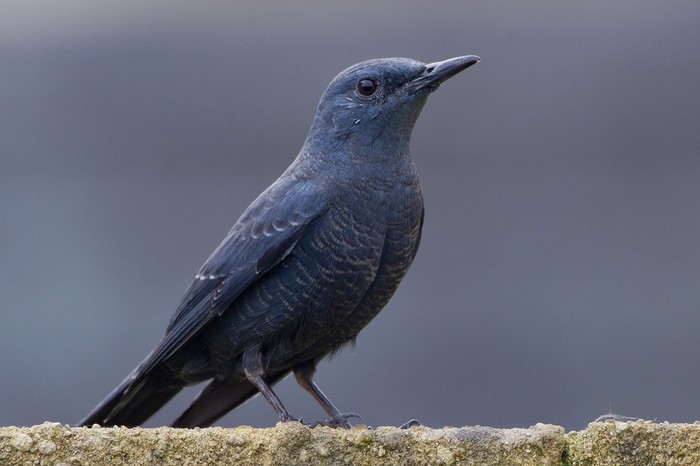
Much as with any number of recently accepted Hooded Mergansers there’s now little to debate for the BBRC, assuming it doesn’t do anything daft. The rumblings of discontent, those murmurings suggesting dubious origins, motorway accidents, will never be resolved (in an alleged Zoothera-like styleee). Indeed those murmurings have all but subsided as listers availed themselves of this less-than-10 records mega, those fascinating shots of an ankle adornment nothing more than a memory.
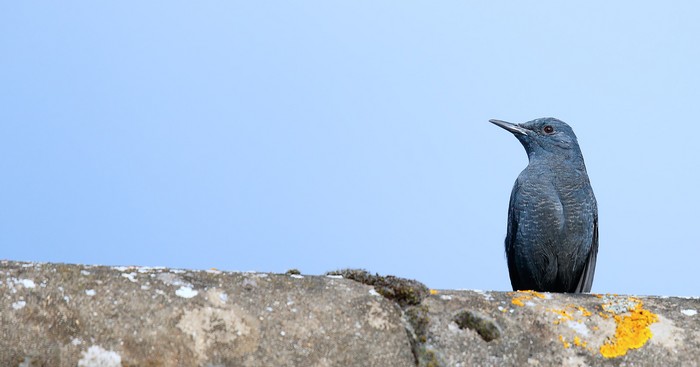
If there’s no hard and fast evidence to suggest a little bit of oi-oi, how’s your father, funny business, then this glorious show-stopper will, like those perky Presidential quackers, ease himself gently in to the record books as another quite remarkable bird of recent times.
That Lesser White-fronted Goose should feature so high up within a rarity round up is one of the more depressing aspects of recent times, such is the decrease in vagrant numbers here now it genuinely warrants mega status.
After lurking out-of-bounds on Foulness for since the hefty East Anglian arrival of Russian White-fronts back in mid-December through until at mid-January, it was anyone’s guess as to whether the bird had departed back into the European mainland or maybe even drifted north a little, to Suffolk or Norfolk, where numbers of the commoner cousins have remained pretty high, right up until now. As it turned out, this particular Lesser White-fronted Goose hadn’t moved far at all - just a short time was spent on Wallasea (on the morning of 26th) before departing back across the River Roach, out on to the inaccessible confines of Foulness.
Thirty years ago, Lesser White-fronted Goose would have been seen as nothing more than the dreaded "old hat rare", pretty much annual with the WWT reserve at Slimbridge producing the goods with numerous new arrivals through until the late 80’s (with other vagrants arriving at goosing hot=spots around the county every once in a while).
The only other Essex record of this increasingly rare vagrant came in that golden era of Lesser White-fronted Goose arrivals, a group of three 1w’s logged on Foulness on October 12th 1986.
Bar just two blank years, the species was recorded annually from 1958 to 1989. After a gap until 1994, accepted records were logged through ’94 to ’98 - and then the crash came…until this winter’s bird on Foulness and Wallasea, there had been just three records across the entire 2000’s; a one-day bird on North Uist in February 2001, at Slimbridge for almost a fortnight in mid-February 2003 and the wintering bird Norfolk’s Yare Valley (with the Taiga Bean Geese) from December 2010 to January 2011 and again from December 2011 to the end of February 2012.
Pacific Diver has something of a struggle on hand to keep people interested these days, a victim of a decade of well twitched individuals, one of which has been on the winter agenda for the whole time since those dizzying days of early 2007 when this gorgeous diver found a place on the British List…
As has been mentioned in past years around this time, the number of accepted records actually fails to convey just how rare this species remains here - until this winter 19 accepted records referred to perhaps no more than six or seven individuals, the most recent "new" one being the summer adult off the southern tip of the Shetland mainland in May 2013.
Two new juveniles in recent weeks has been an exciting development and one of those, the youngster at East Chevington NWT (Northumberland) remained until the final day of the month, having been in the area for over a month now.
A few hundred miles to the southwest, that old-time favourite remained in Mount’s Bay, noted off Penzance on 22nd - it was first noted, in almost the same spot, near the Jubilee Pool on February 17th 2007, the third record of Pacific Diver within six weeks of a quite remarkable spell, an event that was one of the highlights of the year back then.
There’s never been a mid-winter with three Pine Buntings to play with before, but there’d never been an autumn such as last year to play with before - upwards of 10 or more recorded - so it wasn’t a massive surprise when birds were found within winter feeding flocks of finches and buntings.
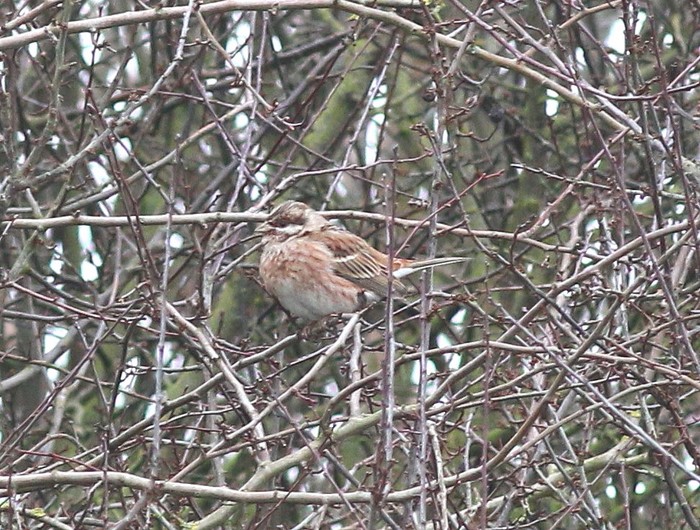
That New Year opening act in Shropshire appears to be long gone but at least one of the birds found later in January remained in place this week - the male still on his winter residence at Dunnington (North Yorkshire) until 28th.
With new individuals still being discovered on the continent, you can’t help but think that perhaps somewhere in a east coast hedgerow there’s another one or two to be found.
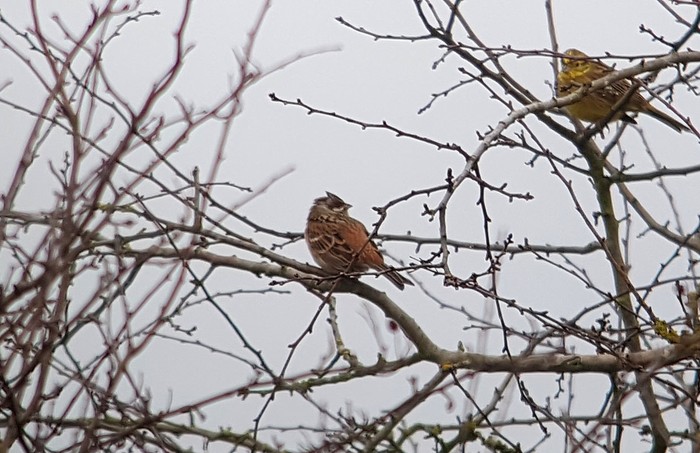
Hooded Merganser is, of course, far rarer than the species directly above, but there’s just something a little "fake" about these super sawbills.
This particular fine looking male, still on Barr Loch, Lochwinnoch RSPB (Clyde) has been in southwest Scotland since early October and is heading rapidly towards a sixth month in and around the country.
Those who felt it had a better feel-good-factor than a couple of recent tame-looking female-types in the south and have journeyed to Clyde or Ayrshire to see this dapper drake over the winter will be hoping that, come sometime around mid-to late March or early April, it departs the scene - look out Hebrides, you may be on for another one.
We’re in to the first of four birds that have, at one point or another in the recent past, been the subject of much taxonomic debate. Two have been elevated to full species status across the past decade or so, one is awaiting someone, somewhere doing the right thing while another will have swung from rare form to rare species and, come 01-01-18, revert back to rare form status only.
Northumberland’s drake Black Scoter remained off Goswick across 25th-28th having last been noted there on February 18th.
This will be the same drake that has been noted off the coast of the northeastern county since 2015 and is probably the drake noted off Bamburgh in April 2011.
With almost four whole months on the calendar, the gorgeous wintering male Eastern Black Redstart continued to draw a trickle of admirers to Skinningrove (Cleveland) until 28th.
To date, each of the recent British records (right back to 2003 at least) of this spectacular looking form of Black Redstart have been "paradoxus" first-winter males, birds that show obvious adult male plumage characteristics, notably that deep orange-red belly - so we may be missing females and non-"paradoxus" birds, or perhaps these distinctive birds from Central Asia (of the form phoenicuroides) somehow have more of a migratory instinct.
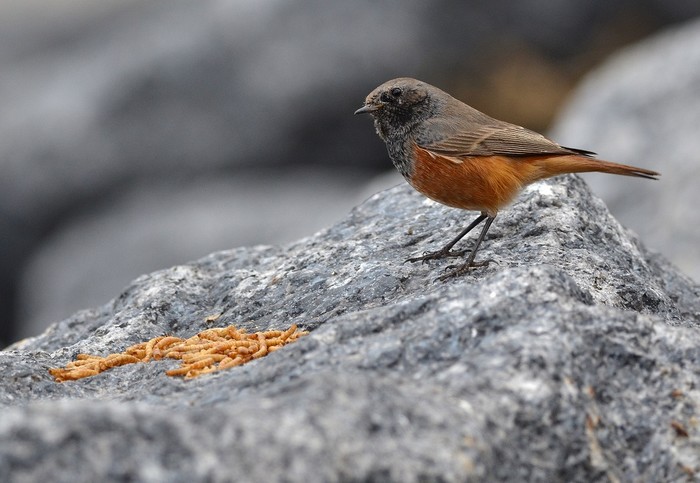
For a while now there’s been a feeling that somewhere in the realms of the test-tube and the laboratory, there was a species or two to be split within the Black Redstart complex (though who needs a DNA sample, it looks obvious in the field). One look at a male Western Black Redstart (one of the handsome gibraltariensis that we see around these parts) and a male Eastern Black Redstart shows radically different looking birds and it is so hard to see how they are actually one in the same thing.
Maybe those who sit upon the IOC will have another read of the paper by Ertan, published in 2006, which not only showed just how divergent phoenicuroides was but also that it was a closer match to Hodgson’s Redstart than it was to "our" (Western) Black Redstart.
They do appear to be poles apart and maybe the split is actually "ours" away from all those different red-bellied birds way out east - that makes an awful lot of sense on paper. And in the field too.
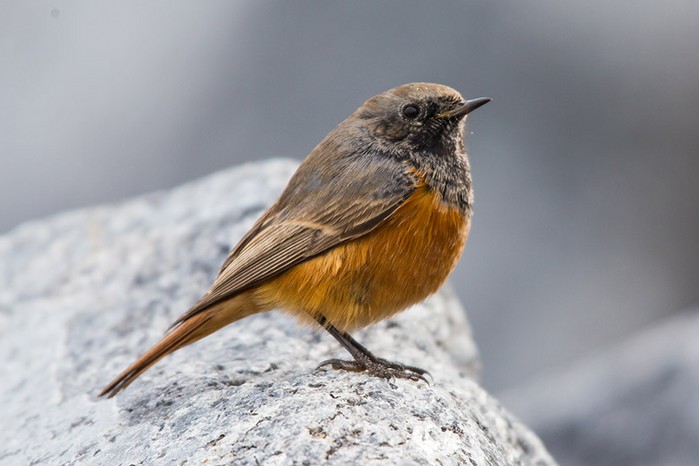
…which isn’t quite the case for Hudsonian Whimbrel and the commoner white-rumped "European" counterpart that we are all so familiar with. The North American form had long been considered to be a valid split and, by 2011, the BOURC-TSC took hold of the all the evidence provided and graciously afforded many a pleasing armchair tick to 100’s of us.
By the time 2018 comes around, it will be back to sub-specific status and the pain of erasing this particular Transatlantic vagrant will be felt by countrywide - those journeys to Wales, Cumbria, Shetland, Scilly, Sussex and Cornwall all being rendered in vain (in vain only in a listing context, these are fine looking birds and that’s what really matters).
The Cornish Hudsonian Whimbrel decamped from Scilly to arrive on the beaches around Marazion on October 30th 2015 and despite some leaves of absence (presumably to not too far away) it has been in the area ever since and was still at Boat Cove, Perranuthoe to 28th.
Finally to the top end of Orkney and to North Ronaldsay where the fine adult male Northern Harrier which made another flight across the island on 23rdthrough to 27th.
In these volatile (and exciting) taxonomic times (see above), it was interesting to read a week or so back that, following the surprise rejection by the AOU’s taxonomic working party for full-blown species status 12 months+ ago (at around the same time that the dying embers of our very own Taxonomic sub-committee gave us one final parting gift), the Americans are to review the non-split decision, it appears to be up for grabs again for those in the Nearctic.
There’s no danger here of seeing another species demoted from those glorious capitals to inglorious lower case, the defunct BOURC-TSC’s decision is one that is also recognised by the IOC, so it stays firmly in BIG LETTERS.
Kicking the new week off were the single Pomarine Skua logged off Marazion (Cornwall) and the Little Auk that headed past Tiree (Argyll & Bute), both on 22nd. A further five of the latter were reported from Sheringham (Norfolk) the following day, when four Balearic Shearwaters headed past a blustery Godrevy Point (Cornwall). Also caught up in Storm Doris was a brief Grey Phalarope at Porth Ysgaden (Gwynedd) on 23rd.
The week’s fifth Balearic Shearwaters was seen from St. Mary’s (Scilly) on 26th while two or three further Pomarine Skuas were noted around Penzance and Mousehole (Cornwall) across 25th-26th.
No new buttery-billed beasts to mention this week, the only White-billed Diver to offer being the regular adult still in the waters of South Ronaldsay (Orkney) to 26th.
Cattle Egrets continued to dominate this week, especially if you lived in our four southwestern most counties - upwards of 80 seen with Cornwall scoring highest with at least 35 through the week, including 12 at St. Clement and 15+ on the Helford River, both on 26th (following 17 near Helston on 25th) with seven still on the Gannel Estuary, Newquay, also on 26th. Devon scored 24, with 11 remaining at Tamerton Foliot until 22nd with two fives on 26th, at Teigngrace and South Milton Ley.
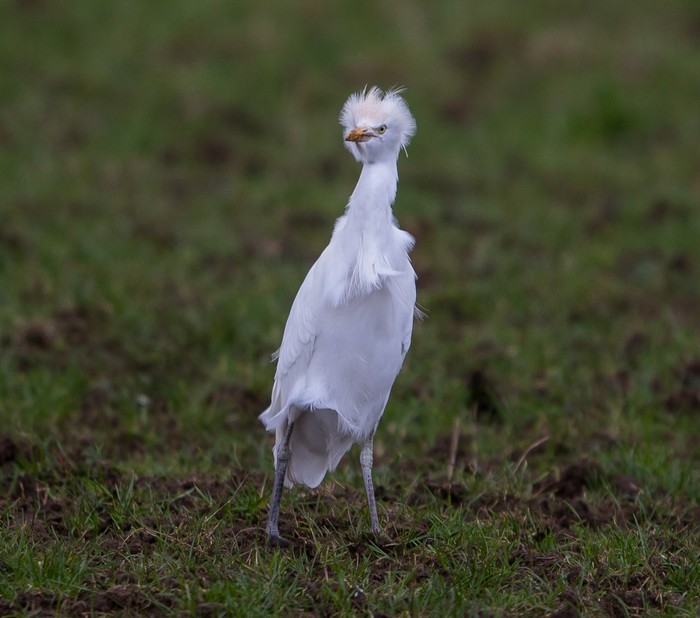
Five of Dorset’s double figure haul were at Little Cheney until 25th and nine were noted departing the Lodmoor RSPB roost on the morning of 28th (with three at Portesham the same day) while Somerset managed three singles through the week. Elsewhere, the South Midlands managed eight (five in Gloucestershire and three in Worcestershire), the southeast of England managed a further three singles and then an impressive eight at Freshwater (Isle of Wight) on 27th. At last seven were in the northwest (including six still near Birkdale, Southport on 22nd) while East Anglia, Scotland and Wales managed one Cattle Egret each. A further 18 birds were in Ireland, 10 of them in County Cork with a single still at Pilmore and with nine near Carrigaline, all on 22nd, with the final eight still in place at Tomhaggard (Co. Wexford) to 25th rounding off a grand weekly score of 118 in all.
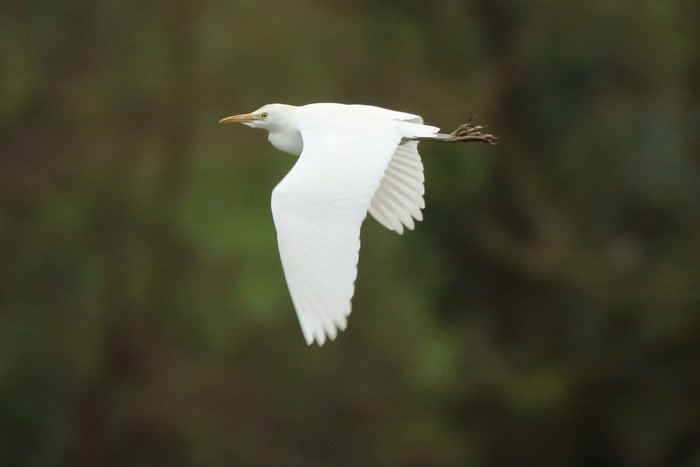
Only six Glossy Ibis to report this week; on 24th, a lone bird was reported from Leicestershire, at Wanlip Meadows LRWT while 25th saw a single noted again at Ely (Cambridgeshire) with 26th seeing two birds logged again at Ham Wall RSPB (Somerset) and another appeared again in Aberdeenshire, at Loch of Strathbeg RSPB. The week concluded with news of the bird remaining at Thorncross (Isle of Wight) on 28th.
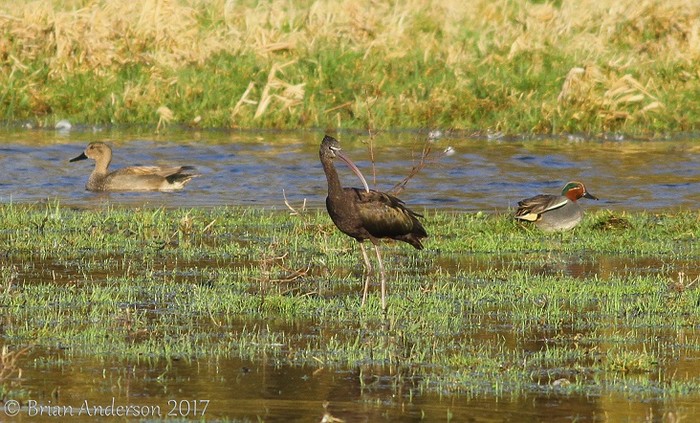
Spoonbills are heading the way of the long-departed Great White Egret and won’t be a regular feature of the round-ups from now on - unless there’s a significant number to report. For one last time though, there were 39 birds noted across eight coastal counties this week, including 14 at Arne RSPB (Dorset) on 24th, eight at Keyhaven (Hampshire) on 26th with at least four back around the north Norfolk coast too. (For those who’d like to know, Great White Egret remains widespread, with oodles of 1’s, 2’s and 3’s on offer this week).
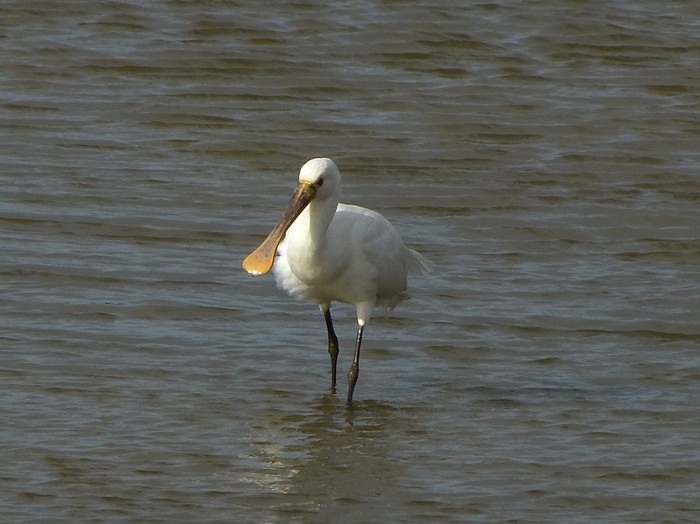
Trying to do their best and be all incognito were four foot tall Common Cranes; 22 regulars were seen at Eldernell, along the Nene Washes (Cambridgeshire) on 25th and then on 27th came perhaps the most notable event of the week, when a flock of 36 birds flew north over Sandwich Bay (Kent) - presumably wintering birds from France or further south losing their bearings as they tracked north to breeding grounds in northern Europe. What a tremendous sight that must have been - they will surely be picked up somewhere else won’t they?
Not much goosing to be had this week, the cream-of-the-crop (small, eyeringed beastie aside) was the Todd’s Canada Goose reported from Dunfanaghy New Lake (Co. Donegal) on 25th.
Four Black Brants got a mention; the first of the new week was seen at Whitstable (Kent) on 22nd and was followed by adults at Kilnsesa (East Yorkshire) from 22nd-27th, Eastney (Hampshire) on 24th and West Mersea (Essex) on 25th-27th.
In Highland, the drake Black Duck kept drawing trickle of admirers to Strontian until at least 25th while a couple of drake Lesser Scaups were recorded as "still present" at either end of the country - one was still on Loch of Boardhouse, Birsay (Orkney) to 26th and the long-returning drake remained at Dozmary Pool (Cornwall) to 28th.
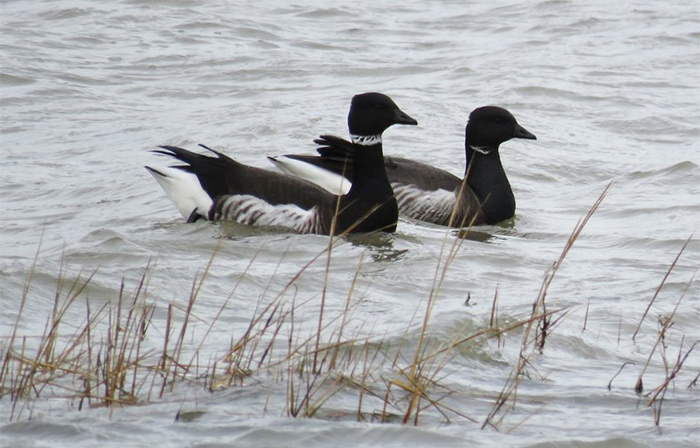
5:2:2 were the national tallies for Ring-necked Duck this week with Ireland seeing three remain near Ballybay (Co. Monaghan) to 24th with a single female at Tuosist (Co. Kerry) until 22nd and a male at Union Hall (Co. Cork) through until 26th. In Scotland, lone drakes remained at Carlingwark Loch (Dumfries & Galloway) until 23rd and Pitlochry (Perth & Kinross) until 28th while England’s two were winter regulars, the Dungeness drake seen until at least 25th and the Cambridgeshire duck at Paxton Pits until 28th.
Half of the week’s American Wigeon (all bar one of them drakes) were seen in Scotland; one was still at Hunterston (Ayrshire) to 25th and Highland birds were noted near Clachnaharry, Inverness to 26th, at Udale Bay RSPB to 27th and at Tain to 28th.
Two English drake American Wigeons lingered Exminster Marshes RSPB (Devon) until 26th and at Grindon Lough (Northumberland) to 28th while new was a 1w female on the pools at Grimley (Worcestershire) on 27th-28th. In west Wales, the final drake of the week was on the Gann Estuary (Pembrokeshire) throughout the week.
Eleven drake Green-winged Teals had an even distribution across England, Scotland and Ireland - five were noted around England with "new" individuals appearing at Saltholme Pools RSPB (Cleveland) from 24th (perhaps last year’s bird?), Greylake RSPB (Somerset) from 25th and in Dorset at Abbotsbury on 26th and Lytchett Bay on 28th while the usual bird remained at Ashleworth Ham NR (Gloucestershire) for much of the week.
Three island birds were in Scotland; still on North Ronaldsay (Orkney) to 23rd, on Loch an t-Saile, South Uist (Outer Hebrides) on 25th and Loch Gruinart RSPB, Islay (Argyll & Bute) on 26th while Ireland’s trio were at Lurgangreen (Co. Louth) on 22nd, Ballymena (Co. Antrim) to 23rd and near Timoleague (Co. Cork) to 24th.
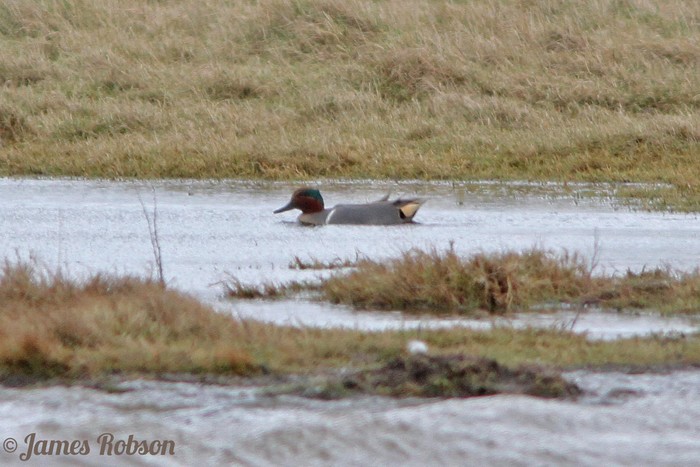
Until Monday morning, there was just one Surf Scoter to mention this week, a drake off the expansive beach at Murvagh (Co. Donegal) on 24th. That changed on 27th when the returning drake was again off the River Esk river mouth (Lothian) and five drakes were seen in Lower Largo (Fife).
Both of the week’s King Eiders were also Irish birds - the queen remained at Castlegregory (Co. Kerry) to 26th and the king was back in Sligo’s Ballysadare Bay on 24th (he’d been AWOL for over a month).
With three and a half months already chalked up, the wintering Shetland Killdeer was still knocking around the Sandwick area of Mainland on 24th-28th meaning it had passed the century mark for days on site, 108 by close of play.
Only one other Killdeer (out of some 82 in all) has ever made it to a three figure stay before and that bird too was on the Shetland Mainland, from April to November 2007, 213 days logged (and it was probably the same bird that spent over 40 days around the same part of south Mainland in March the following year).
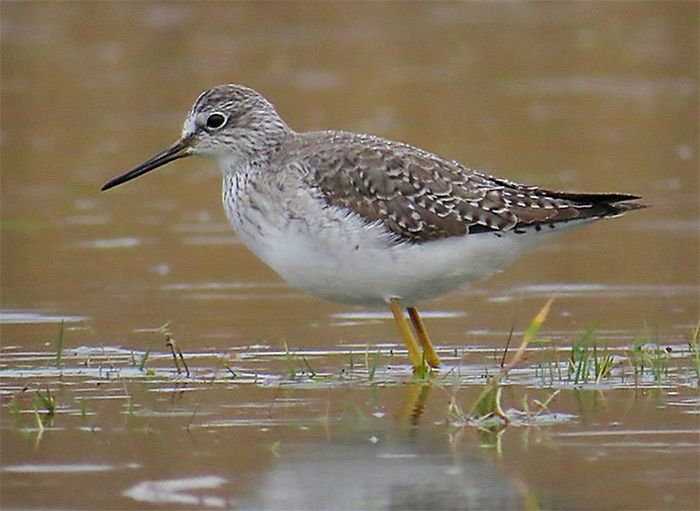
Another long-staying Nearctic shorebird was the Dorset Lesser Yellowlegs that remained in the favoured haunt of Lytchett Bay until 28th.
Far less common as a wintering species goes is Temminck’s Stint but the recent bird in Staffordshire remained around Branston GPs until 24th (having first been noted there on January 2nd.
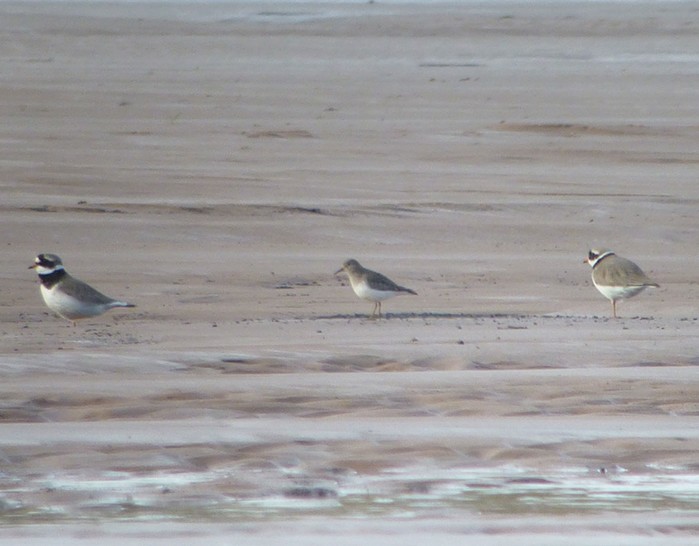
The only Bonaparte’s Gull this week was the adult that appeared again in Clyde, at Cardwell Bay on 24th and 26th-27th.
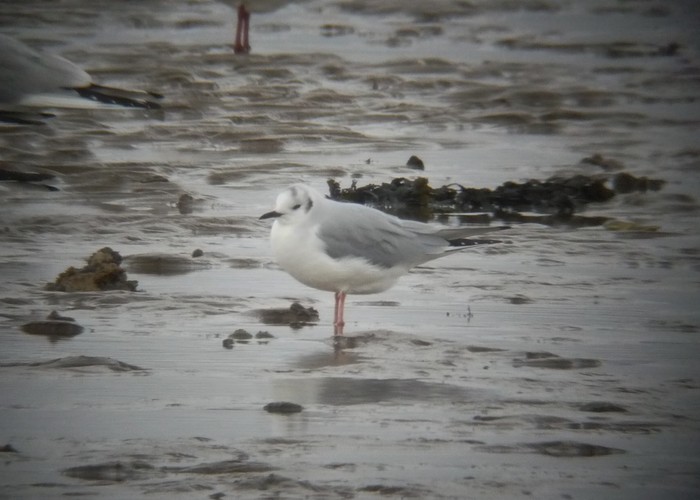
Seven of the week’s 12 Ring-billed Gulls were reported from Ireland - two twos noted (both adult/1w combos) from Doorly Park, Sligo (Co. Sligo) on 22nd and Tralee Bay Wetlands (Co. Kerry) on 25th. Single regular adults were in Cork (at Timoleague), Louth (at Dundalk) and Galway (Nimmo’s Pier) through the week and a second-winter remained at Ennis (Co. Clare) until 28th.
Other Celtic first-winters were on the Gannel Estaury (Cornwall) on 22nd-23rd and Loch Gruinart, Isaly (Argyll & Bute) on 24th-26th, with Wales registering a second-winter in Ceredigion, at Aberystwyth on 23rd and a first-winter on the Gann Estuary (Pembrokeshire) on 28th. An adult was noted at Lytchett Bay (Dorset) on the afternoon of 26th and again on both 27th and 28th.
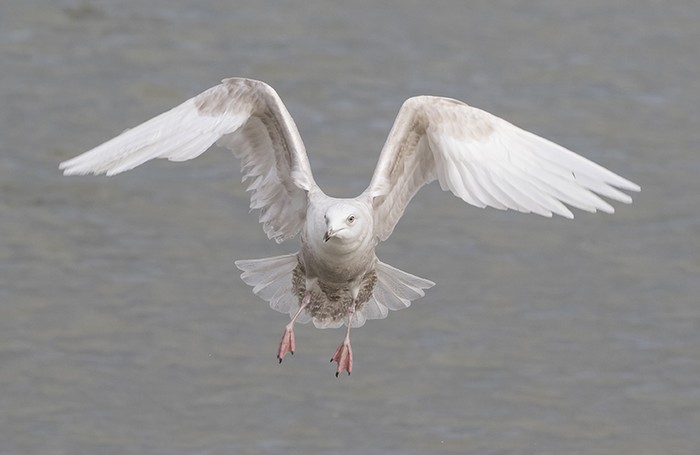
Half a dozen Kumlien’s Gulls included two juveniles still in Stornoway harbour, Lewis (Outer Hebrides) at the start of the week when an adult was noted at Rufforth (North Yorkshire) - the latter showing again on 25th. Another English bird, a juvenile this time, was at Portland Bill (Dorset) for a short while on 23rd when a juvenile was also seen at Belfast Lough RSPB (Co. Antrim). The final bird this week was yet another youngster, also in Ireland, seen at Bray (Co. Wicklow) on 26th-28th.
Iceland Gulls remained out in force this week, some 159 recorded across 42 British and Irish counties. Scotland led the way with at least 51 birds (in eight counties/regions) with 1 high of 10 in Stornoway harbour, Lewis (Outer Hebrides) on 22nd, part of a total of some 25 for the island chain. Six birds were seen at Lossiemouth (Moray) on 26th and at least six were seen around Highland. A minimum 45 were recorded in eight Irish counties, with Killybegs in County Donegal registering nine on 24th while eight remained in Sligo to 22nd. A further five were seen in the Nimmo’s Pier area (Co. Galway) on 23rd and 11 were in County Kerry, including four in Dingle harbour and three in Ferriter’s Cove, all on 27th.
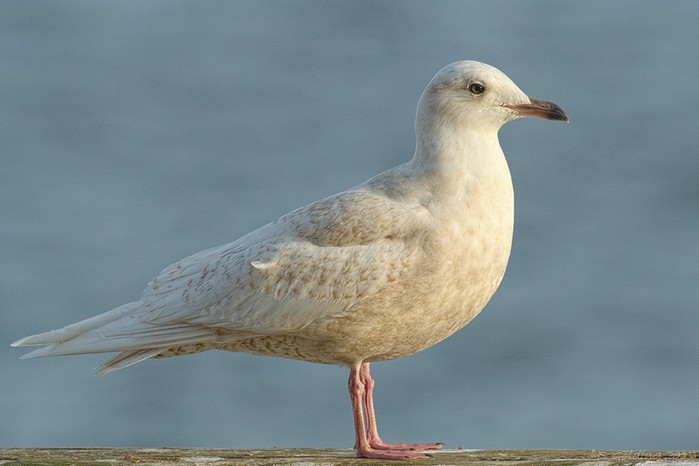
Northeastern England recorded some 19 birds in all, including at least five around Rufforth on 22nd while East Torkshire, County Durham and Northumberland saw at least three different birds noted through the week. At least 17 Iceland Gulls were in the far southwest (including fives for both Cornwall and Dorset), the northwest logged 11 (five of them in Lancashire) with six and five for the Midlands and southeast respectively. Wales managed just the one.
Not too far behind was Glaucous Gulls which managed a very respectable 130+ birds, also from 42 British and Irish counties. Scotland again fared well, with at least 55 reported from 10 counties and regions including at least 17 around the Hebrides and six on Tiree, at Loch Bhasapoll on 23rd. Another five were at Peterhead (Aberdeenshire) on 25th. At least 18 Irish birds were well spread around nine counties while Wales managed seven birds in four counties, including at least three (probably four or five) in Ceredigion.
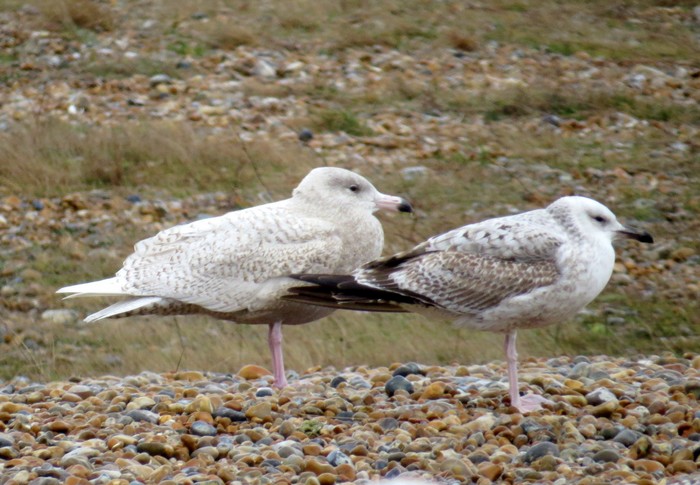
Rufforth again scored highly this week, with six brids noted there on 22nd (there were upwards of 16 in North Yorkshire alone over the past seven days but it is tough to work out how many were repeats between sites). As many as 11 Glaucks were in East Anglia, with seven reported around the Norfolk coast, while the Midlands managed eight, the northwest seven with four and three for the southwest and southeast respectively.
Something of a slow-burner was the juvenile Pallid Harrier seen around the Holkham area of Norfolk - it initially started out as a "probable" after the first sighting on 24th and the identification firmed up on 27th after examination of photos taken at the time.
As it happened, the bird was seen again over Lady Ann’s Drive and the grazing marsh at Holkham on the same date as the pix were scrutinised and the hunt was on around the expansive environs of north Norfolk.
If accepted, this will become the 10th Pallid Harrier in the county, all of them coming since the winter of 2002, reflecting the national upward spiral for these fine raptors. Indeed, Norfolk has hosted the species for all bar one year (2011) in the last eight and this week’s is the third to be seen in a winter period.
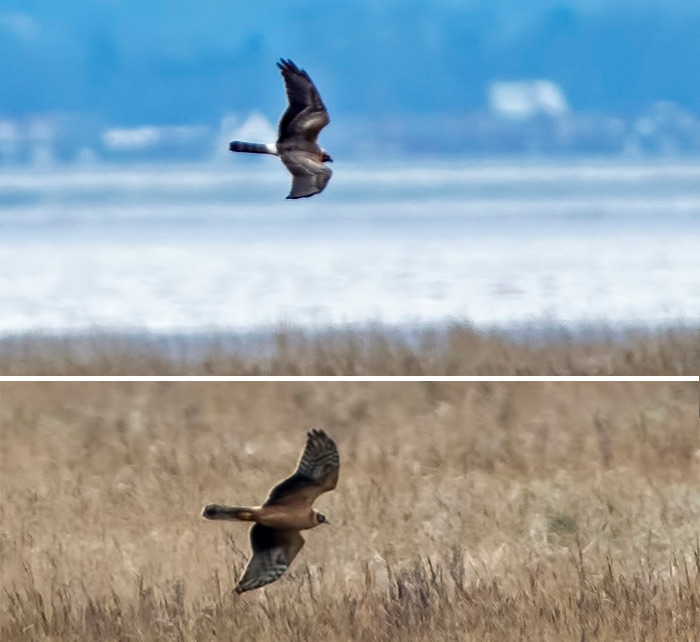
In East Yorkshire, the wintering juvenile female Pallid Harrierwas at Kilnsea on 24th before returning to Welwick Saltmarsh YWT where it was seen on 25th-26th, so ruling out early thoughts that it had moved across the Humber and the Wash to relocate to Norfolk.
A couple of adult male Rough-legged Buzzards were still on site at favoured East Anglia venues through until the end of the weekend; at the Haddiscoe Forest and also nearby St. Olaves (Norfolk) to 28th and at Thorney Toll (Cambridgeshire) to 26th.
Birders busy taking in the wintering male Pine Bunting in North Yorkshire this weekend would have enjoyed the news of a fine padder within a stone’s throw of Dunnington’s premier rare - in nearby Hagg Woods a Coues’ Arctic Redpoll was found on 25th (in a mixed flock of, soon-to-be-one-in-the-same flock of "Mealy" and "Lesser" Redpolls) and it was still on site the following day.
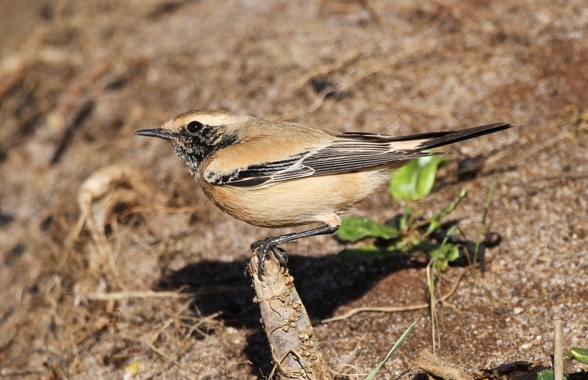
Rather less seasonal goodies that continued to attract visitors through much of the week included the rather obliging first-winter male Bluethroat at Willow Tree Fen LWT (Lincolnshire) until 28th and in Devon, the sub-singing wintering male Desert Wheatear also lingered at Thurlestone until the end of the month - this is just the county’s seventh record of the species and the first since 2011 and he’s rapidly approaching a full four months on site (assuming he stays put until March 8th).
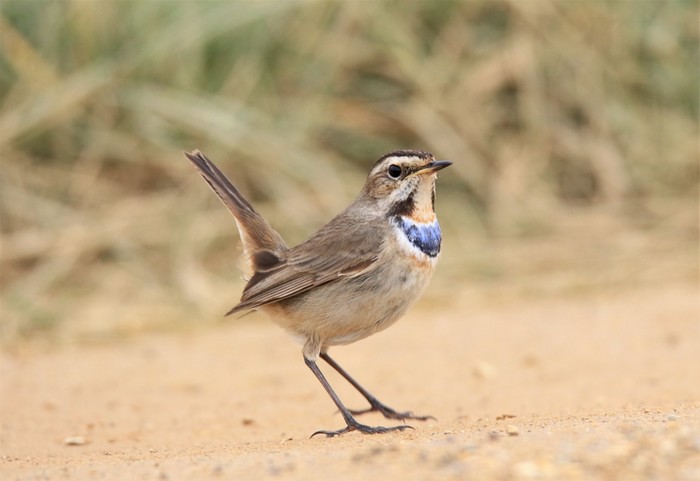
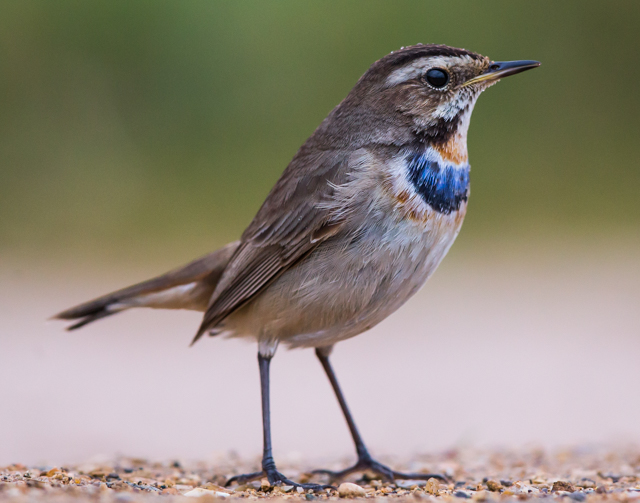
Along the south coast and in to Dorset now where the popular Portland Hume’s Yellow-browed Warbler made it in to another week, present close to the edge of Weston on 22nd-26th at least. Three Yellow-browed Warblers were at Staverton (Devon) on 23rd with another some six miles away, at Cornworthy, to 25th. A further Devonian winterer remained at Topsham to 28th with another not far away on the same day, this one in Exmouth. Another loner was seen at Tehidy CP (Cornwall) for much of the week while two hid behind Swanpool, Falmouth to 27th. Away from the far southwest, in Staffordshire, one remained around the sewage works at Whittington until 26th and a Welsh bird was noted at Llanharan (Glamorgan) on 24th.
The wintering East Sussex Serin stayed put at Tide Mills until the end of the weekend while the recent three Richard’s Pipits all lingered for another week - one at Arlingham (Gloucestershire) and two at Abbotsbury (Dorset) - seen to 27th and 28th respectively.
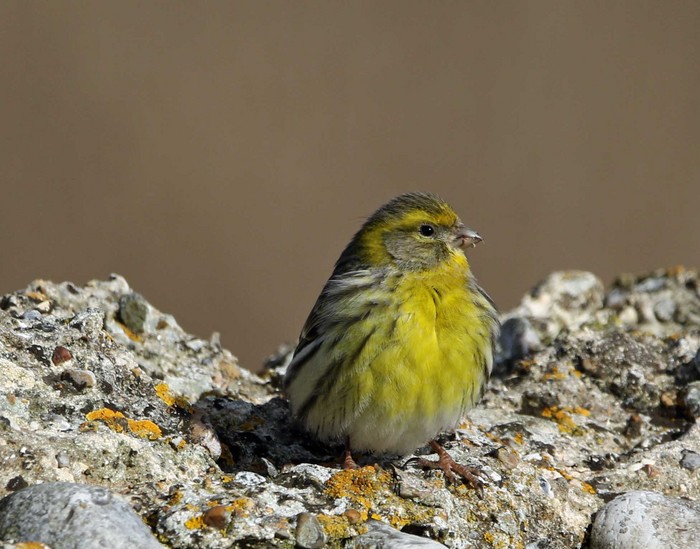
Both wintering Rose-coloured Starlings were noted again this week, still in Dorchester (Dorset) to 26th and Crawley (West Sussex) to 28th.
The new week began with at least nine Great Grey Shrikes on station with the final haul over the last seven days being 27+. Southeastern England fared best, at least eight birds noted, including three (or four) in Hampshire, two (or three) in the New Forest and another at Cranes Moor on 26th. Three birds were in Sussex, in the West single birds were at Bury Hill on 22nd and Waltham Brooks SWT on 26th while another remained in the East, in the Ashdown Forest to 22nd. Singles were also seen in Surrey, on Frensham Common and Thursley Common NNR until the end of the weekend and beyond, while in Berkshire one was at Wishmoor Bottom on 25th.
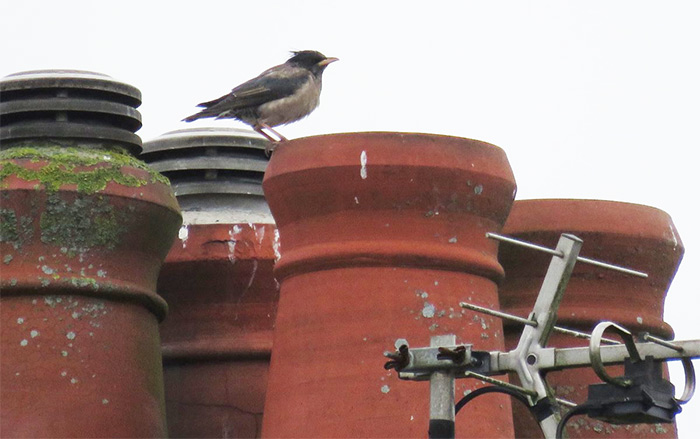
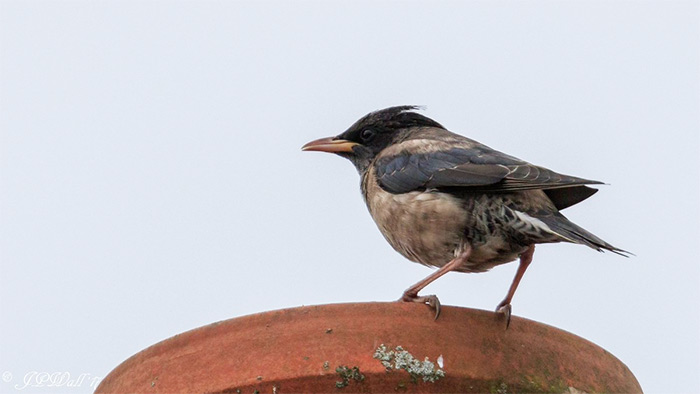
Three regions scored four - in the northeast, birds were at Deeping St. Nicholas (Lincolnshire) from 22nd-24th, near York (North Yorkshire) from 22nd-23rd and, in the same county, the Langdale Forest on 24th with another still at Prestwick Carr (Northumberland) to 28th. East Anglian Great Greys included two in Cambridgeshire, at Burwell on 24th and Wicken Fen NT on 24th-25th with a couple around the Breckland borders, near Elevden (Suffolk) on 26th-28th and Grimes’ Graves (Norfolk) on 26th-27th with another Norfolk bird again near Cockley Cley on 27th-28th. In the southwest of England, one or two birds were in Dorset, at Wareham Forest and Hartland Moor on 22nd and 23rd, two were in Somerset, at Aisholt and Porlock, while the traditional site in Devon, the expansive moorland and conifer belt at Soussons, near Warren House Inn, held one through to 24th.
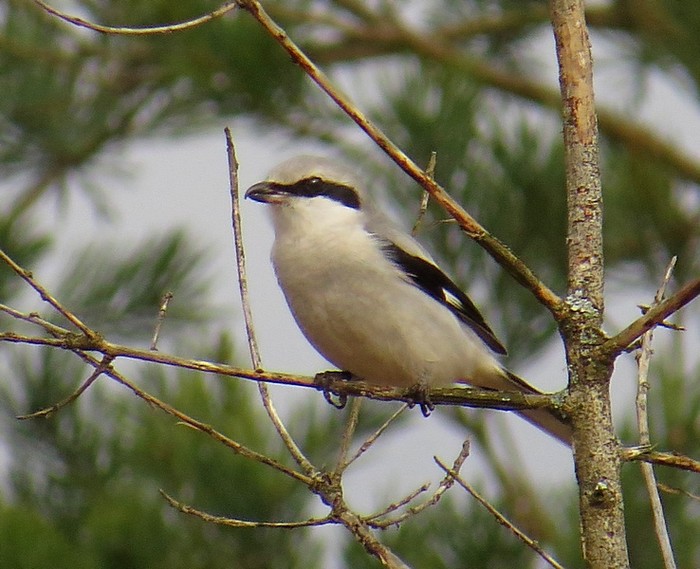
Making up the numbers, four birds in the Midlands, one in Shropshire’s Black Hill area to 24th, two in Gloucestershire, at Frampton-upon-Severn (also to 24th) and in the Forest of Dean, at Crabtree Hill to 23rd at least and in Nottinghamshire, at Normanton on Soar, on 27th Singletons at Great Broughton (Cumbria) on 24th, in Scotland, at Drumoak (Aberdeenshire) on 22nd-28th and in Wales, at Tongwynlais (Glamorgan) on 28th.
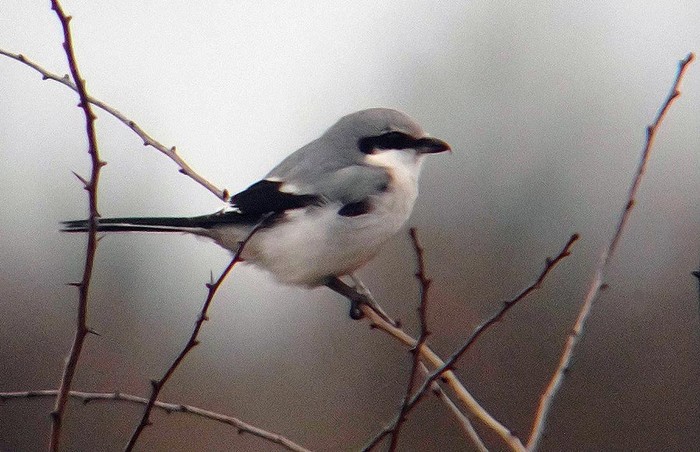
Having been away for some while, I thought I’d show willing and try and work out just how many Waxwings were spread around the country - well, that’s at least 45 minutes of my life I won’t be getting back - but the totals show an impressive 2694 (give or take one or two, here and there) dotted around the country. The Midlands came out highest with some 865 in the region including 100+ for both Mansfield and Nottingham on 22nd and 24th (out of a county total of 400 or more). Another three figure flock was at Sharrow (South Yorkshire) on 25th, the county hosting some 285 or more through the week. A flock of 80 at Bottesford (Lincolnshire) pushed to the region’s total past the 700 mark.
The week’s largest single gathering seems to have been at Sandbach (Cheshire) on 26th - 120 birds counted there - part of the northwest’s 250 or so. Scotland managed some 250 in all, with 270 in the southeast (including 70+ at East Melling in Kent on 26th) with East Anglia managing 180 (mostly in Suffolk) with a solid 30+ in the far southwest. Ireland managed a dozen in County Clare, at Ennis on 26th-27th, the first record for the county since 2012.
Finally, Bedfordshire fine record of a wintering Little Bunting continued to attract folk this week, the bird remaining on site through until 28th.
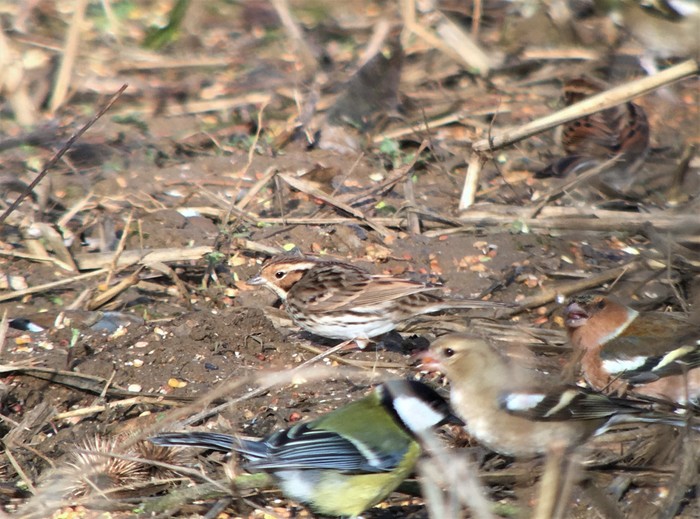
The outlook appears to be, generally, remaining on the mild side with sou’west to westerly winds and moist Atlantic air in charge.
With that in mind, it seems unlikely that too much will change across the next week and the opportunities for new rarities does, on paper at least, seem slender.
However 2016 proved, once and for all, that the unexpected is to be expected and 2017 may follow suit (we’re due a duff year soon surely?)
The options could include American Herring Gull, a species that has a habit of throwing up new birds in late winter (at least a dozen fresh arrivals recorded in the week ahead) while, rarer still (and the proud owner of specific status come January 2018) is Thayer’s Gull - the Rufforth juvenile of 2015 was found on March 2nd and the cute, soft-toned youngster on the Mullet was located on March 5th 2005. Further back in time, exactly 20 years ago this week, a juvenile was located on the rubbish dumps of Antrim, on March 1st 1997.
Another really rare gull that caused a who-ha at the time was the third-winter Glaucous-winged Gull that appeared on the river at Ferryside in Carmarthenshire on March 2nd 2007, offering the first chance to twitch this, at the time, British first (if you remember, it went missing after a few unavailable December days in Gloucester waste land).
If the winds moved to the south, there’s every chance of a south coast Northern Wheatear, Sandwich Tern or Sand Martin popping up (a couple of already managed that as the week closed, ditto House Martin) and with them could come one of those nice, early Red-rumped Swallows (or maybe something better, an early Woodchat or Night Heron).
There is one really rare bird that still catches the eye (more so even than the Devonian Black-and-white Warbler from 39 years ago) and that is - of course - the Spurn Tengmalm’s Owl…
…yes, it gets trotted out every year as March approaches and will continue to be trotted out every year until there’s finally been one that allows us to finally bury that notorious ghost, once and for all. If you weren’t birding and twitching at the time, it really is hard to convey the fury that ensued as news of the bird’s presence seeped out not long after departure. You think people were wound up by a captive Booby? Well, that’s nothing compared to the venom and ire that circulated for months and months afterward the events of March 1983.
It was well documented that Spurn’s precarious geography and ecosystem was under immense pressure at the time, but that still meant little to the 400 or 500 drop-everything souls who would have moved heaven and earth to have a shot at the remarkable bird that appeared on March 6th and which was trapped on both 7th and 16th, staying through until March 27th.
Things are remarkably different at Spurn now (and have been for two decades or more) and those dark days of the early 80’s are a dim and distant memory. Anyone who paid a visit to the Siberian Accentor last autumn will be only too aware of what a magnificent job the locals did in not only disseminating the news as quickly as they could, but also in marshalling their own troops to warden the lane, as well as a peninsula rammed to the gunnels with great birds, for however long it took.
The openness with regard to news release of everything around the expansive Spurn recording area is a country mile from way-back-when. Their unstinting welcome to thousands of birders across their fantastic site is something to be admired and, more importantly, appreciated.
That said, 34 years on, that Owl still hurts. A lot…
Mark Golley
1 March 2017
Share this story






